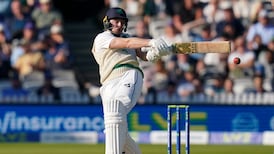THE RATHER depressing performance by the Irish international athletics team in Morton Stadium last week set many people of a certain age thinking of a more glorious past when Irish athletes were highly respected in many disciplines, not least in what the Americans have dubbed field events.
Recently, I came across a fascinating personal account of the career of a Waterford man, Peter O'Connor, who held the world long jump record for 20 years back in the first quarter of the century.
But O'Connor was not the only Irish athlete of his day to set new world marks. The late, P D Mehigan suggested that Thomas Francis Kiely from Ballyneale in Tipperary was the greatest Irish athlete of that particular glorious era, when he won what was then regarded as the all round championship of the world twice, in 1904 and 1906.
It would appear that the all round world championship would be similar to the decathlon. In any event, Kiely went to St Louis in the United States at the age of 34 and beat everybody including the American holder E H Clarke. He returned to the US two years later to repeat the feat.
But to get back to Peter O'Connor and his beautifully, written account of his own budding interest in the event in which he was to become the best in the world. O'Connor recalled: "Having inherited a natural gift of suppleness and spring, without which no athlete, no matter how he trains can hope to win a world record, I became imbued with the ambition, when a small lad, to reach by doing a hop step and jump from the doorstep of my home, a grass margin, over an intervening gravel space.
"My first attempt was many feet short but I was determined to succeed and so it became a habit of mine, almost every morning, to take this exercise for several years and I ultimately succeeded in not only reaching the grass margin but went many feet beyond it."
That was the springboard which resulted in O'Connor breaking the world long jump record in the RDS in Ballsbridge in August of 1901 with a leap of 24 ft 11 3/4 in.
O'Connor developed his own strategy, using techniques which could scarcely be bettered even today.
He decided early on in his long jumping career that speed allied to accurate judgment on hitting the board, allied to height, would be crucial elements in his approach. He writes: "I conceived an idea of my own that to cover a big distance you must, in addition to speed, rise high in the air.
"I therefore erected high jump sticks about 12 or 13 feet from the take off at a height of about three and a half feet and it meant a certain lift and contraction of the body to clear the obstacle when accomplishing the jump.
"By constant practice and by slightly increasing the distances and heights of the high jump obstacle, I made steady progress and finally it came quite naturally to me, without having the high jump lath, to get the required height automatically and thus I finally established my world record.
"Many Irish, English and, American newspapers commented on my peculiar style, stating that I seemed to wriggle or make a second jump midway in the air. That was as a result of the habit I acquired in getting over the high jump lath when practising."
O'Connor goes on: "In addition, I cultivated great speed to the take-off which hurled me through the air with such velocity that I invariably fell forward landing and never back.
"At the Olympic Games in "Berlin in 1936 I noticed that the world famed Jessie Owens gave the same wiggle or lift in the air more than midway from the take off and landed forward exactly as I used to."
In his later years, he seemed to feel that the minds of the young people had become distracted. In Ireland he opined: "We have football and hurling through the summer months and our youth prefer indulging in these games which, of course, afford them abundant exercise and without much restriction of the normal pleasures. While, if they follow up their special event in athletics, they MUST avoid smoking and drinking and late hours and have the necessary enthusiasm to train methodically and regularly.
"I'm afraid our Youths of today are not prepared to do this. They have too many pleasures to distract them."
What the poor man would say today about the distractions which beset young people one can only guess.
What is sad, however, is that the excellence in athletics which seemed to grip the entire country in those days has been dissipated to the extent that very few people turned up for the European Cup event at Morton Stadium last weekend, even though some of the finest athletes in Europe were competing.
One can only wonder where we lost our way from the halcyon days of O'Connor and Kiely and their likes.










